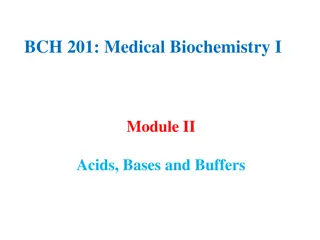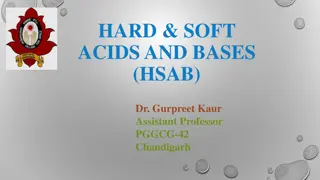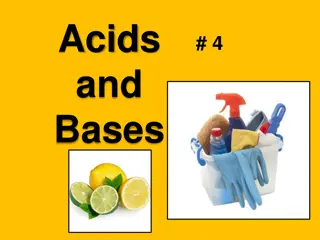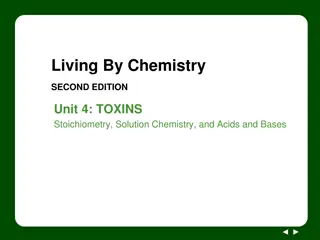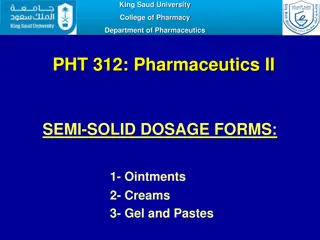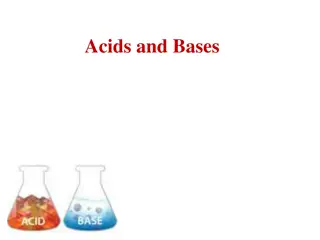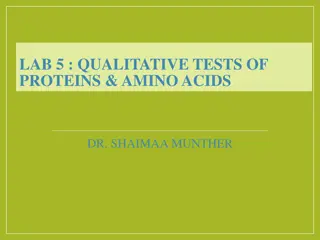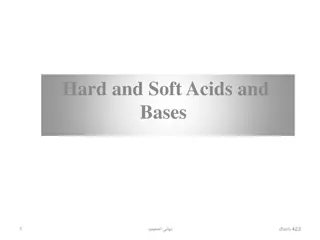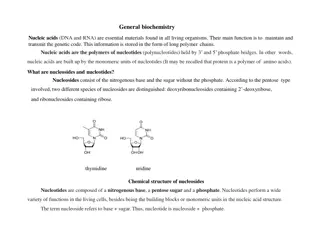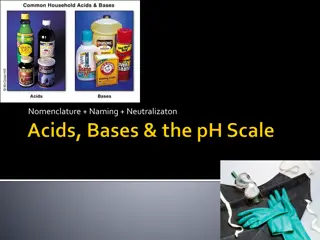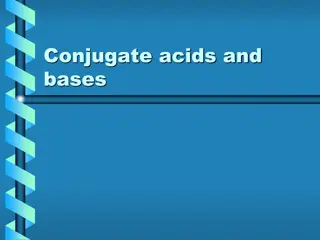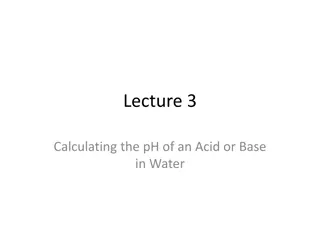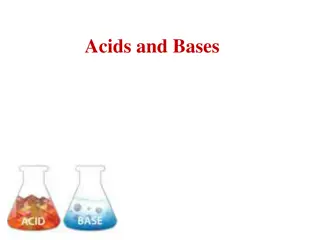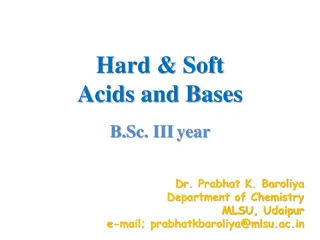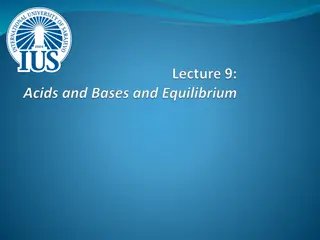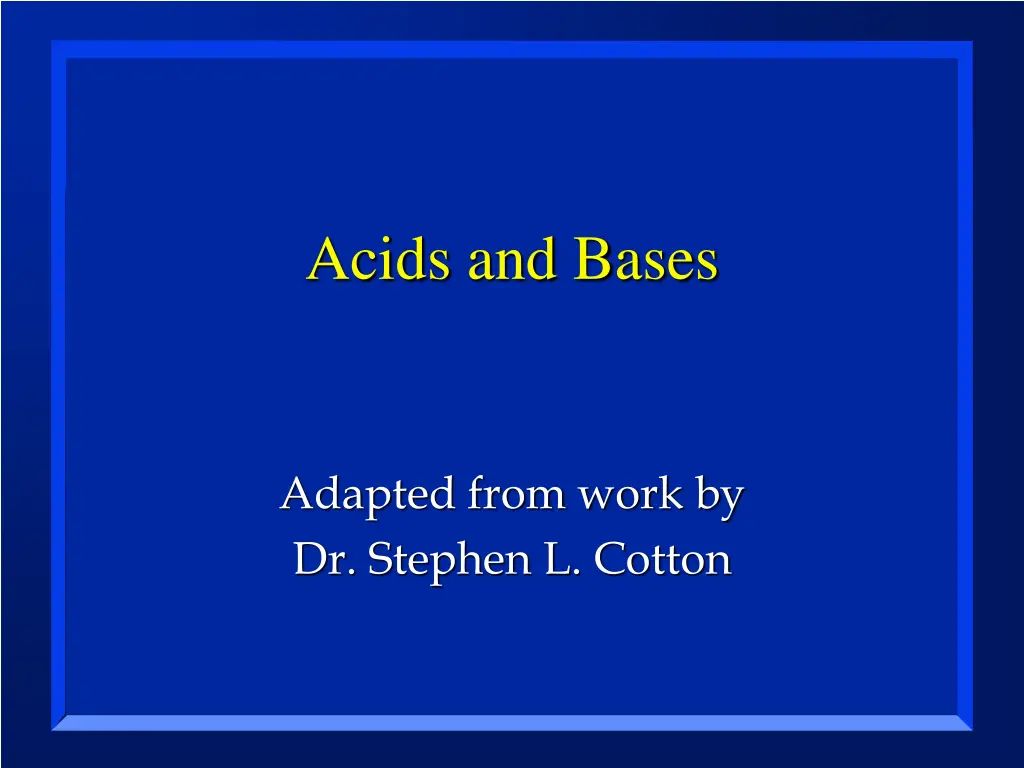
Understanding Acids and Bases
Explore the fundamental concepts of acids and bases, including properties, equilibria, and equilibrium constants. Learn about reversible reactions, Le Chatelier's Principle, and how to express equilibrium in terms of numerical values. Understand the equilibrium constant expression and how it determines whether products or reactants are favored at equilibrium.
Download Presentation

Please find below an Image/Link to download the presentation.
The content on the website is provided AS IS for your information and personal use only. It may not be sold, licensed, or shared on other websites without obtaining consent from the author. If you encounter any issues during the download, it is possible that the publisher has removed the file from their server.
You are allowed to download the files provided on this website for personal or commercial use, subject to the condition that they are used lawfully. All files are the property of their respective owners.
The content on the website is provided AS IS for your information and personal use only. It may not be sold, licensed, or shared on other websites without obtaining consent from the author.
E N D
Presentation Transcript
Acids and Bases Adapted from work by Dr. Stephen L. Cotton
Equilibria revision Reversible Reactions In a reversible reaction, the reactions occur simultaneously in both directions double arrows used to indicate this 2SO2(g)+ O2(g) 2SO3(g) In principle, almost all reactions are reversible to some extent
Equilibria revision Le Chatelier s Principle If a stress is applied to a system in dynamic equilibrium, the system changes to relieve the stress. Stresses that upset the equilibrium in a chemical system include: changes in concentration, changes in temperature, and changes in pressure
Equilibria revision Equilibrium Constants (Keq) Chemists generally express the position of equilibrium in terms of numerical values These values relate to the amounts of reactants and products at equilibrium (the reaction quotient)
Equilibrium revision Equilibrium Constants consider this reaction: aA+ bB cC + dD The equilibrium constant (Keq) is the ratio of product concentration to the reactant concentration at equilibrium, with each concentration raised to its coefficient in the balanced equation
Equilibrium revision Equilibrium Constants consider this reaction: aA+ bB cC + dD Thus, the equilibrium constant expression has the general form: [C]cx [D]d [A]ax [B]b Keq = ( [ ] = molarity )
Equilibrium revision Equilibrium Constants the equilibrium constants provide valuable information, such as whether products or reactants are favoured: Keq > 1, products favored at equilibrium Keq < 1, reactants favored at equilibrium
Defining Acids and Bases OBJECTIVES: List the properties of acids and bases.
Defining Acids and Bases OBJECTIVES: Name an acid or base, when given the formula.
Properties of acids Taste sour (don t try this at home). Conduct electricity. Some are strong, others are weak electrolytes. React with metals to form hydrogen gas. Change indicators (blue litmus to red). React with hydroxides to form water and a salt.
Properties of bases React with acids to form water and a salt. Taste bitter. Feel slippery (don t try this either). Can be strong or weak electrolytes. Change indicators (red litmus turns blue).
Names and Formulae of Acids An acid is a chemical that produces hydrogen ions (H+) when dissolved in water Thus, general formula = HX, where X is a monatomic or polyatomic anion HCl(g) named hydrogen chloride HCl(aq) is named as an acid Name focuses on the anion present
Names and Formulas of Acids 1. When anion ends with -ide, the acid starts with hydro-, and the stem of the anion has the suffix -ic followed by the word acid 2. When anion ends with -ite, the anion has the suffix -ous, then acid 3. When anion ends with -ate, the anion suffix is -ic and then acid.
Names and Formulas of Bases A base produces hydroxide ions (OH-) when dissolved in water. Named the same way as any other ionic compound name the cation, followed by anion To write the formula: write symbols; write charges; then cross (if needed)
Hydrogen Ions and Acidity OBJECTIVES: Given the hydrogen-ion or hydroxide-ion concentration, classify a solution as neutral, acidic, or basic.
Hydrogen Ions and Acidity OBJECTIVES: Convert hydrogen-ion concentrations into values of pH, and hydroxide-ion concentrations into values of pOH.
Hydrogen Ions from Water Water ionizes, or falls apart (dissociates) into ions: H2O H+ + OH- Called the self-ionization of water Occurs to a very small extent: [H+ ] = [OH-] = 1 x 10-7 mol dm-3 Since they are equal, a neutral solution results from water Kw = [H+ ] x [OH-] = 1 x 10-14 mol2 dm-6 Kwis called the dissociation constant of water
Dissociation Constant of water H2O H+ + OH- Kw is constant in every aqueous solution: [H+] x [OH-] = 1 x 10-14 mol2 dm-6 If [H+] > 10-7 then [OH-] < 10-7 If [H+] < 10-7 then [OH-] > 10-7 If we know one, other can be determined If [H+] > 10-7 , it is acidic and [OH-] < 10-7 If [H+] < 10-7 , it is basic and [OH-] > 10-7 Basic solutions are also said to be alkaline
Logarithms and the pH concept Logarithms are powers of ten. Review from earlier lessons, and p. 585 definition: pH = -log[H+] in neutral pH = -log(1 x 10-7) = 7 in acidic solution [H+] > 10-7 pH < -log(10-7) pH < 7 (from 0 to 7 is the acid range) in base, pH > 7 (7 to 14 is base range)
pH and pOH pOH = -log [OH-] [H+] x [OH-] = 1 x 10-14 M2 pH + pOH = 14 Thus, a solution with a pOH less than 7 is basic; with a pOH greater than 7 is an acid
[H+] 10010-1 10-310-510-710-910-1110-1310-14 pH 0 1 3 5 7 9 11 13 14 Acidic Neutral Basic 14 13 11 9 7 5 3 1 0 pOH 10-14 10-13 10-11 10-9 Basic 10-7 10-5 10-3 10-1 100 [OH-]
Measuring pH Why measure pH? Everything from swimming pools, soil conditions for plants, medical diagnosis, soaps and shampoos, etc. Sometimes we can use indicators, other times we might need a pH meter
Acid-Base Indicators An indicator is an acid or base that undergoes dissociation in a known pH range, and has different colours in solution. Examples: litmus, phenolphthalein, bromthymol blue, methyl orange
Acid-Base Indicators Although useful, there are limitations to indicators: usually given for a certain temperature (25 oC), thus may change at different temperatures what if the solution already has colour? ability of human eye to distinguish colors
Acid-Base Indicators A pH meter may give more definitive results some are large, others portable works by measuring the voltage between two electrodes needs to be calibrated
Acid-Base Theories OBJECTIVES: Compare and contrast acids and bases, as defined by the theories of Arrhenius, Br nsted-Lowry, and Lewis
Acid-Base Theories OBJECTIVES: Identify conjugate acid-base pairs in acid-base reactions.
Svante Arrhenius Swedish chemist (1859-1927) - Nobel prize winner in chemistry (1903) One of the first chemists to explain the chemical theory of the behavior of acids and bases
Arrhenius Definition Acids produce hydrogen ions, H+(aq), in aqueous solution. Bases produce hydroxide ions, OH- (aq), when dissolved in water. Limited to aqueous solutions. Only one kind of base (hydroxides) NH3 (ammonia) could not be an Arrhenius base.
Polyprotic Acids Some compounds have more than 1 ionizable hydrogen. HNO3 nitric acid - monoprotic H2SO4 sulfuric acid - diprotic - 2 H+ H3PO4 phosphoric acid - triprotic - 3 H+ Having more than one ionizable hydrogen does not mean stronger!
Polyprotic Acids However, not all compounds that have hydrogen are acids Also, not all the hydrogen in an acid may be released as ions only those that have very polar bonds are ionizable - this is when the hydrogen is joined to a very electronegative element
Arrhenius examples... Consider HCl What about CH4 (methane)? CH3COOH (ethanoic acid, or acetic acid) - it has 4 hydrogens like methane does ?
Brnsted-Lowry Definitions Broader definition than Arrhenius Acid is hydrogen-ion donor (H+ or proton); base is hydrogen-ion acceptor. Acids and bases always come in pairs. HCl is an acid. When it dissolves in water, it gives it s proton to water. HCl(g) + H2O(l) H3O+ + Cl- Water is a base; makes hydronium ion.
Acids and bases come in pairs... A conjugate base is the remainder of the original acid, after it donates it s hydrogen ion A conjugate acid is the particle formed when the original base gains a hydrogen ion Indicators are weak acids or bases that have a different color from their original acid and base. Conjugate acid-base pairs differ in structure by exactly one hydrogen ion.
Acids and bases come in pairs... General equation is: HA(aq) + H2O(l) H3O+(aq) + A-(aq) Acid + Base Conjugate acid + Conjugate base NH3 + H2O NH4+ + OH- base acid c.a. c.b. HCl + H2O H3O++ Cl- acid base c.a. c.b. Amphoteric can behave as both an acid or base depending on circumstances. Amphiprotic is able to both donate and accept a hydrogen ion
Lewis Acids and Bases Gilbert Lewis focused on the donation or acceptance of a pair of electrons during a reaction Lewis Acid - electron pair acceptor Lewis Base - electron pair donor Most general of all 3 definitions; acids don t even need hydrogen!
Strengths of Acids and Bases OBJECTIVES: Define strong acids and weak acids.
Strengths of Acids and Bases OBJECTIVES: Calculate an acid dissociation constant (Ka) from concentration and pH measurements.
Strengths of Acids and Bases OBJECTIVES: Arrange acids by strength according to their acid dissociation constants (Ka).
Strengths of Acids and Bases OBJECTIVES: Arrange bases by strength according to their base dissociation constants (Kb).
Strength Strong acids and bases are strong electrolytes They fall apart (ionize) completely. Weak acids don t completely ionize. Strength different from concentration Strong-forms many ions when dissolved Mg(OH)2 is a strong base - it falls completely apart when dissolved. But, not much dissolves- not concentrated
Measuring strength Ionization is reversible. HA H+ + A- This makes an equilibrium Acid dissociation constant = Ka Ka = [H+ ][A- ] (water is constant) [HA] Stronger acid = more products (ions), thus a larger Ka
What about bases? Strong bases cause complete dissociation of water. B + H2O BH+ + OH- Base dissociation constant = Kb Kb = [BH+ ][OH-] [B] (we ignore the water) Stronger base = more dissociated, thus a larger Kb.
Strength vs. Concentration The words concentrated and dilute tell how much of an acid or base is dissolved in solution - refers to the number of moles of acid or base in a given volume The words strong and weak refer to the extent of ionization of an acid or base Is concentrated weak acid possible?

